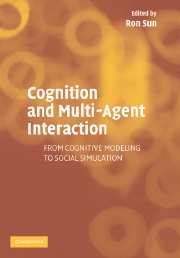Book contents
- Frontmatter
- Contents
- List of Contributors
- Preface
- PART 1 INTRODUCTION
- PART 2 OVERVIEWS OF COGNITIVE ARCHITECTURES
- 2 Modeling Paradigms in ACT-R
- 3 Considering Soar As An Agent Architecture
- 4 The CLARION Cognitive Architecture: Extending Cognitive Modeling to Social Simulation
- PART 3 MODELING AND SIMULATING COGNITIVE AND SOCIAL PROCESSES
- PART 4 A SYMPOSIUM
- Index
3 - Considering Soar As An Agent Architecture
Published online by Cambridge University Press: 15 December 2009
- Frontmatter
- Contents
- List of Contributors
- Preface
- PART 1 INTRODUCTION
- PART 2 OVERVIEWS OF COGNITIVE ARCHITECTURES
- 2 Modeling Paradigms in ACT-R
- 3 Considering Soar As An Agent Architecture
- 4 The CLARION Cognitive Architecture: Extending Cognitive Modeling to Social Simulation
- PART 3 MODELING AND SIMULATING COGNITIVE AND SOCIAL PROCESSES
- PART 4 A SYMPOSIUM
- Index
Summary
INTRODUCTION
The Soar architecture was created to explore the requirements for general intelligence and to demonstrate general intelligent behavior (Laird, Newell, & Rosenbloom, 1987; Laird & Rosenbloom, 1995; Newell, 1990). As a platform for developing intelligent systems, Soar has been used across a wide spectrum of domains and applications, including expert systems (Rosenbloom, Laird, McDermott, Newell, & Orciuch, 1985;Washington & Rosenbloom, 1993), intelligent control (Laird, Yager, Hucka, & Tuck, 1991; Pearson, Huffman,Willis, Laird,& Jones, 1993), natural language (Lehman, Dyke, & Rubinoff, 1995; Lehman, Lewis, & Newell, 1998), and executable models of human behavior for simulation systems (Jones et al., 1999;Wray, Laird, Nuxoll, Stokes, & Kerfoot, 2004). Soar is also used to explore the integration of learning and performance, including concept learning in conjunction with performance (Chong & Wray, to appear; Miller & Laird, 1996), learning by instruction (Huffman & Laird, 1995), learning to correct errors in performance knowledge (Pearson & Laird, 1998), and episodic learning (Altmann & John, 1999; Nuxoll & Laird, 2004). This chapter will introduce Soar as a platform for the development of intelligent systems (see also Chapters 2 and 4). Soar can be viewed as a theory of general intelligence, as a theory of human cognition, as an agent architecture, and as a programming language. This chapter reviews the theory underlying Soar but considers Soar primarily as an agent architecture. The architecture point-of-view is useful because Soar integrates a number of different algorithms common in artificial intelligence, demonstrating how they can be used together to achieve general intelligent behaviour.
- Type
- Chapter
- Information
- Cognition and Multi-Agent InteractionFrom Cognitive Modeling to Social Simulation, pp. 53 - 78Publisher: Cambridge University PressPrint publication year: 2005
- 15
- Cited by



